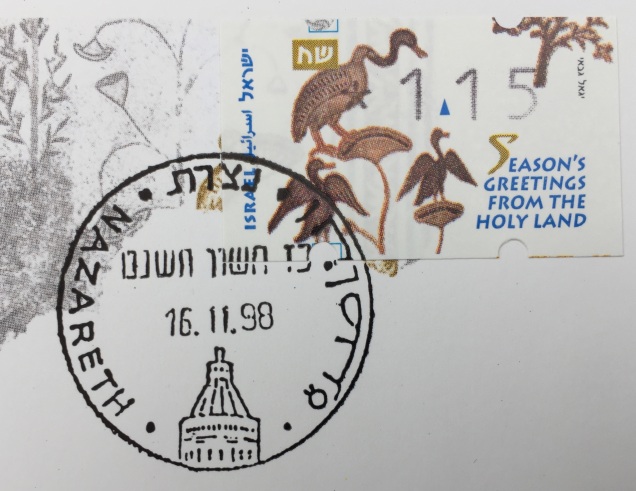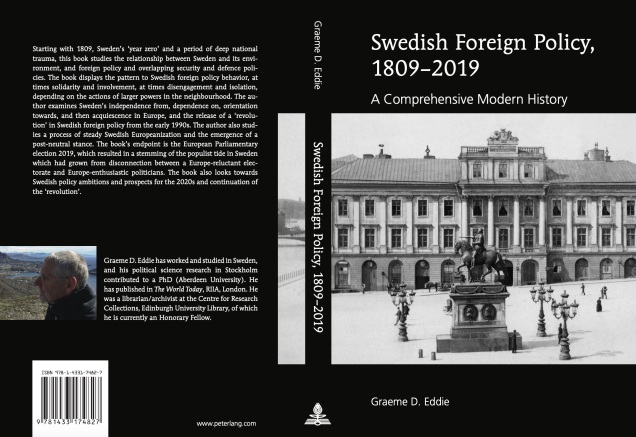
CHRISTMAS – A HOLIDAY OF HOLIDAYS

Yet again, a previous month’s post has offered a convenient segue into the next. In November, mosaics were featured in the yearly exploration of the art, artwork, and design theme, and one of the 5th century mosaics described was the ‘loaves and fishes’ piece that lies in front of the altar in the Church of the Multiplication of the Loaves and Fish at Tabgha on the Sea of Galilee.


The mosaic – one of a number in the Church of the Multiplication – depicted two fish flanking a basket containing four loaves of bread, and it was illustrated on an ATM postage stamp issued on 16 November 1996 (ATMs are self-adhesive variable value stamps issued from automatic self-service vending machines or from counter machines in post offices). Included in the design of the stamp was the Christmas wish: ‘Season’s Greetings from the Holy Land’.

The Declaration of Israeli Independence in 1948 described the country as a Jewish state, but it also stated that it would guarantee religious freedoms and freedom of conscience, language, education and culture to all citizens, and would ensure complete equality of social and political rights irrespective of religion, race or sex. This was important in a country with great diversification of cultures and tradition. Today, around 2% of the total population of Israel – circa 177,000 people – are adherents of the Christian religion (in 2019). Moslems accounted for 17.8% of the population (2019).
The term for a Christian in modern Hebrew is Notzri – or ‘follower of the Nazarene’ – plural Notzrim.

Although the ‘Christmas story’ took place in what is now modern Israel, and modern Palestine – Jesus of Nazareth, born in Bethlehem of Judea – Christmas is not widely celebrated in the country other than among the small Christian population. Christmas is not a public holiday in Israel (Hanukkah is not a national holiday either for that matter though it is a Jewish festival and holiday period for people), and for the majority of Israelis it is a normal working day. Even in Jerusalem, you would be unlikely to see many (or any) signs of Christmas, unless you specifically went to the Old City ‘tourist’ areas, or areas with churches in them.

Indeed, in the history of postal issue in Israel, the word ‘Christmas’ has never been printed on a postage stamp, nor the greeting ‘Merry Christmas’, though these have occurred on postmarks/franking, stationery, the range of Simon’s Maximum Cards, and special First Day Leafs. The more universal ‘Season’s Greetings’ has appeared regularly though on Israeli stamp output.

Christmas services and activities are of course held in the Christian churches of Israel, the most famous of these being the carol concerts and services held at the Dormition Abbey (a Benedictine Monastery) on Mount Zion in Jerusalem. The YMCA in Jerusalem also holds a Christmas bazaar as well as a Christmas Eve carol concert.

The largest Christian population in Israel is in Nazareth (the town where Jesus grew up). Nazareth has lots of Christmas lights on the streets and outdoor markets to celebrate both Christmas and Hanukkah. There is a Christmas Eve parade which ends at the Church (or Basilica) of the Annunciation, a firework display, and midnight mass.

At major Christian places of worship in Jerusalem, Christmas can ‘last’ for up to three weeks, because Roman Catholic and Protestants celebrate the festival on 25 December, Orthodox Christians celebrate on 6 January, and Armenian Christians on 19 January.

Just over the border, in Bethlehem in Palestine (in the West Bank), more Christmas celebrations take place than in much of Israel.

Celebrating the diversity of Haifa – Jewish, Moslem, Christian, Druze, Baha’i – the annual ‘Holiday of Holidays’ is held in the city in December (it had been annual anyway until Covid-19 made its presence during 2020). During the holiday elaborate illuminations and decorations enhance the city’s places of worship and religious gathering, including the Baha’i Temple.

The ‘Holiday of Holidays’ festival was founded in 1994 by Beit Ha-Gefen (the Arab-Jewish Cultural Centre), the Haifa Municipality, and the Wadi Nisnas (formerly mixed Arab and Jewish) neighbourhood of Haifa, as a multi-cultural celebration of the neighbourly relations that exist within Haifa’s diverse population.

In a normal year (without Covid-19), the festival would be held over the weekends of December in galleries and public areas throughout the Wadi Nisnas neighbourhood, the German Colony and the Lower City of Haifa. There would be art exhibitions, movies, concerts (classical Arabic music, world music, traditional Jewish music, and Jewish music with a fusion of Western and Eastern styles), theatre, dance, circus, acrobatics, and street performances, antiques fairs, walking tours, and conferences. There would be a wide array of foods based on local Mediterranean cuisine, al fresco fare in Wadi Nisnas, children’s activities, and a Christmas parade (with Santa Claus).

More than likely, a stranger to Haifa during the ‘Holiday of Holidays’ would be greeted with a hearty.. MERRY CHRISTMAS – CHAG MOLAD SAMEACH !!!! חג מולד שמח

In the construction of this month’s post, the following sources were used: (1) Barry Davis, ‘Being different in Haifa‘, Jerusalem Post, 18 December 2014; (2) the website of the Israel Philatelic Federation; and (3) the website of Ateeme, the place for those interested in variable value stamps, ATMs
A further look at Christmas on Israeli postal output will be taken this time next year… 2021!!!
THE SCOTLAND-BASED AUTHOR OF THIS ISRAELI PHILATELY BLOG HAS RECENTLY PUBLISHED A BOOK ON SWEDISH FOREIGN POLICY (released 8 October 2020), ENTITLED Swedish foreign policy, 1809-2019: A comprehensive modern history (ISBN:978-1-4331-7482-7 Peter Lang AG, New York, Berne, Brussels Oxford, Vienna, Warsaw, 2020) WHICH CAN BE ORDERED FROM PETER LANG PUBLISHING, OR AMAZON, OR YOUR OTHER FAVOURITE ONLINE BOOKSTORE!!!
